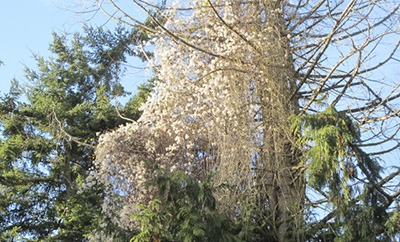by DIDIER GINCIG
Special to the Sounder
Invasive Clematis vitalba (Old Man’s Beard, or also called Traveler’s Joy) is one of the largest noxious plant species by volume and a threat to trees, eventually causing them to collapse.
Its massive network of vines prevents growth of native vegetation, and each stem can produce 30 feet of growth in one season.
The impacts are visible and spreading as this species climbs over forested areas with a rapid growth rate. Growing in abundance on Orcas and San Juan, invasive Clematis vitalba is listed as a Class C noxious weed in Washington but is not required for control in San Juan County at this time, though controlling it is recommended.
It is in seed now, thus easier to see, and each plant can produce over 100,000 seeds. Wind dispersal allows seedlings to quickly colonize surrounding areas.
Fortunately, seedlings can be hand pulled. Larger stems need to be cut. It is recommended to cut them twice, first low to the ground and as high as you can reach.
Yet this Old Man’s Beard has the ability to quickly recover from physical damage by resprouting or by producing roots from stem fragments. The flowering material should not be moved at this time due to the likelihood of dispersing seeds, but cut vine fragments can be piled on a tarp or turned periodically to avoid rooting.
There are various financial issues surrounding the disposal of noxious weeds. The San Juan County Noxious Weed Control Board will be working with transfer stations to establish the most sensible and economic way without necessarily having to ship noxious weeds off island.
County Public Works should be encouraged to make noxious weed removal along county roads a priority.
The approach the county Noxious Weed Control Program is taking is education by providing management strategies and resource assistance. The county has the ability to control and prevent this plant from spreading.
Designating it for mandatory control in this county would have to be approved by the county’s Noxious Weed Control Board. Board representatives are open to public input at http://sanjuan.wsu.edu/noxious/.
Homeowners can do their share by cutting vines and removing roots as you can on your property and by organizing neighborhood work parties.
You can call Judy Jackson, Program Coordinator, and Jason Ontjes, Field Assistant, at the San Juan County Noxious Weed Control Program and they will respond to homeowners’ willingness to help with this invasive species and will be purchasing equipment to loan to the public.
They can be reached at 376-3499 or by email at judy@sanjuanweeds.org and jason@sanjuanweeds.org.
If you have Clematis vitalba on your land or would like to be involved in reducing its effects, get out there and make a difference!
Meanwhile, I’ll be out there doing what I can to help educate the public and motivate a call for action.
Didier Gincig lives on Orcas Island.



